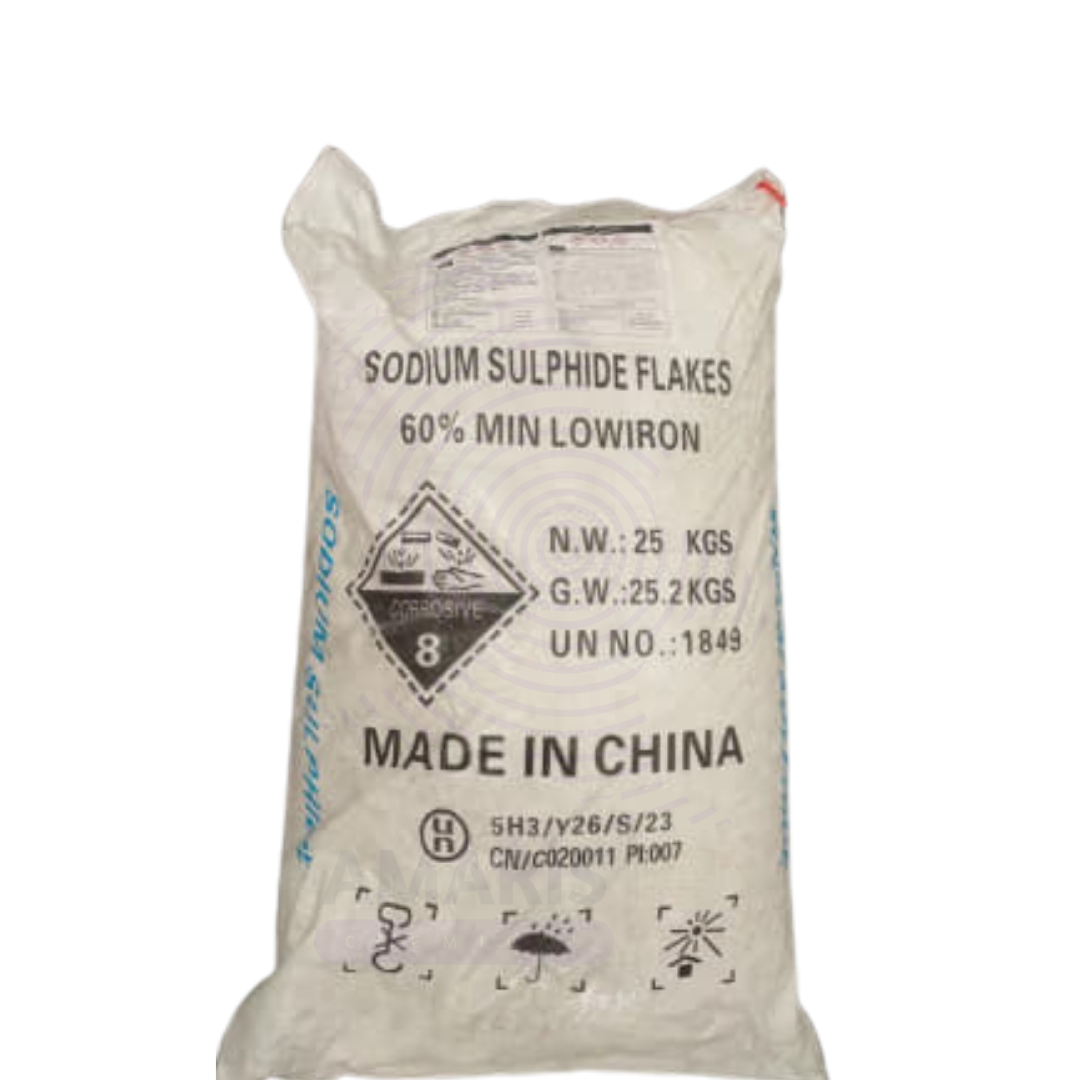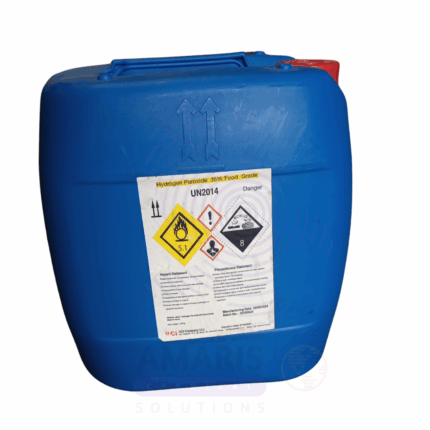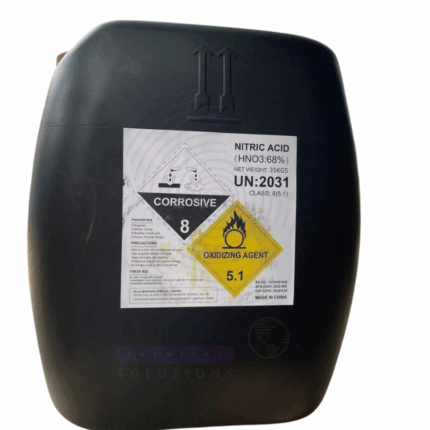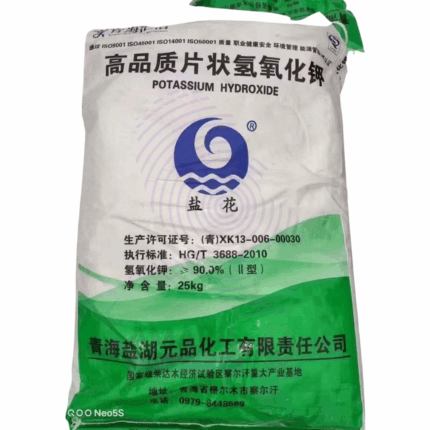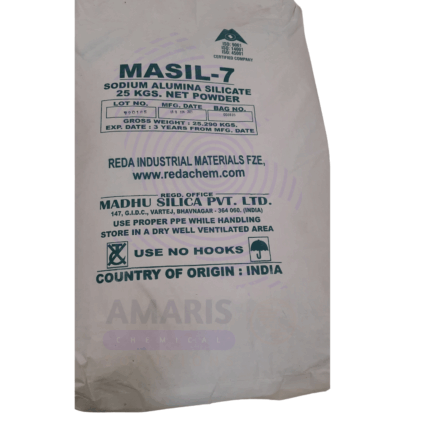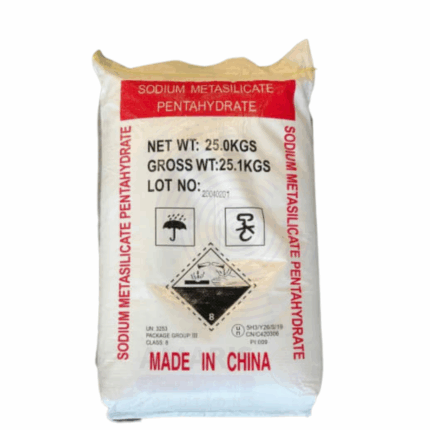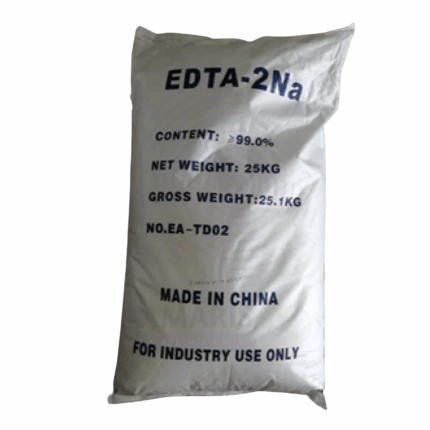
measuring cylinder glass
$ 3.15 Original price was: $ 3.15.$ 3.09Current price is: $ 3.09.

Mechanical Balance
$ 19.70 Original price was: $ 19.70.$ 19.54Current price is: $ 19.54.
Sodium Sulphide
$ 1.10 Original price was: $ 1.10.$ 0.98Current price is: $ 0.98.
Whatsapp Order
Sodium Sulphide (Na₂S) is a yellow to red-yellow crystalline solid or powder with a characteristic odor of hydrogen sulfide. It is highly soluble in water, forming strongly alkaline solutions. This 25kg packaged product is widely used in the chemical, leather, pulp and paper, and textile industries as a reducing agent, sulfur donor, and in flotation processes. Due to its strong reducing properties and reactivity, it must be handled with care under proper safety measures.
Description
Table of Contents
Toggle
Sodium Sulphide
Primary Uses
- Leather Industry
- Dehairing Agent: Used in the liming and dehairing steps of leather processing to remove hair and other unwanted components.
- Tanning Agent: Facilitates sulfide tanning processes.
- Pulp & Paper Industry
- Kraft Pulping: Acts as a reducing agent and chemical in the kraft process to break down lignin and facilitate pulp production.
- Deinking Process: Used to remove inks and other contaminants from recycled paper.
- Chemical Industry
- Sulfur Source: Provides sulfide ions for the synthesis of various sulfur-containing chemicals.
- Flotation Agent: Used in mineral processing to separate ores via flotation techniques.
- Redox Reactions: Employed as a reducing agent in organic and inorganic chemical syntheses.
- Textile Industry
- Bleaching and Dyeing: Used in vat dyeing and as a bleaching agent to remove excess dye.
- Reducing Agent: Maintains reducing environments during dyeing processes.
- Water Treatment
- Oxygen Scavenger: Removes dissolved oxygen from boiler water to prevent corrosion.
- Environmental Applications
- Wastewater Treatment: Used to precipitate heavy metals and neutralize acidic wastes.
Secondary Uses
- Pharmaceutical Industry
- Intermediate: Used in small quantities for synthesis of some pharmaceutical compounds.
- Mining Industry
- Ore Processing: Employed in the flotation and extraction of sulfide ores.
- Laboratory & Research
- Reagent: Utilized as a reducing agent in various analytical and synthetic procedures.
KEY PRODUCT FEATURES
1. Basic Identification Attributes
- Chemical Name (IUPAC): Sodium sulfide
- Common/Trade Name: Sodium sulphide, Sodium sulfide nonahydrate (if hydrated)
- CAS Number: 1313-82-2
- HS Code: 2830.20.00
- Synonyms: Sodium sulfide, Disodium sulfide, Sodium sulfide hydrate (depending on form)
2. Physical & Chemical Properties
- Physical State: Yellow to red-yellow crystalline solid or powder
- Color & Odor: Yellow; strong odor of H₂S (hydrogen sulfide)
- Solubility: Highly soluble in water, releasing alkaline and sulfide ions
- Density: 1.856 g/cm³ (anhydrous)
- Melting Point: 1180 °C (decomposes)
- pH (aqueous solution): Strongly alkaline (pH ~11-14)
- Appearance: Crystalline or granular solid, hygroscopic
3. Safety & Hazard Attributes
- GHS Classification:
- Acute Toxicity (Oral) Category 4
- Skin Corrosion/Irritation Category 1B
- Serious Eye Damage/Eye Irritation Category 1
- Acute Toxicity (Inhalation) Category 3
- Hazardous to the Aquatic Environment (Chronic) Category 2
- Toxicity: LD₅₀ (oral, rat) ~ 207 mg/kg
- Exposure Limits: OSHA PEL: 5 mg/m³ (as sulfide dust/mist)
- Corrosivity: Strongly corrosive to skin and eyes
- Odor Warning: Emits toxic and flammable hydrogen sulfide gas when exposed to moisture or acids
4. Storage & Handling Attributes
- Storage Conditions: Store in a cool, dry, well-ventilated area away from moisture, acids, and oxidizers
- Container Type: 25kg HDPE drums or lined bags, tightly sealed
- Shelf Life: 12 months under proper storage
- Handling Precautions: Use personal protective equipment; avoid contact with skin, eyes, and inhalation; store separately from acids and moisture sources
5. Regulatory & Compliance Attributes
- REACH Registered
- Complies with OSHA Hazard Communication Standard
- UN Number: UN 1829 (Sodium Sulfide, solid, toxic)
- Transport Classification: Class 6.1 Toxic substances
6. Environmental & Health Impact
- Biodegradability: Not biodegradable
- Ecotoxicity: Toxic to aquatic life; LC₅₀ (fish) approx. 10 mg/L
- Bioaccumulation: Not expected
- Aquatic Impact: Harmful if released into water bodies
SAFETY HANDLING PRECAUTIONS
Safety Handling Precautions
- PPE Required: Chemical-resistant gloves, goggles, face shield, respiratory protection in dusty or fume conditions
- Handling Guidelines: Use in well-ventilated areas; avoid moisture contact; use spill containment measures
- Storage Measures: Keep containers tightly closed; isolate from incompatible substances
First Aid Measures
- Inhalation: Move to fresh air immediately; seek urgent medical attention for breathing difficulties
- Skin Contact: Rinse immediately with plenty of water for at least 15 minutes; remove contaminated clothing; seek medical help
- Eye Contact: Rinse thoroughly with water for at least 15 minutes; get immediate medical attention
- Ingestion: Do not induce vomiting; rinse mouth and seek immediate medical attention
Firefighting Measures
- Fire Hazards: May release toxic hydrogen sulfide gas when exposed to acids or moisture
- Extinguishing Media: Use water spray, dry chemical, or foam; avoid dry powders that react violently
- Hazardous Combustion Products: Hydrogen sulfide (H₂S), sulfur oxides (SOx)
Related products
Hydrogen Peroxide Food Grade
Hydrogen Peroxide Food Grade is a highly concentrated aqueous solution of hydrogen peroxide (H₂O₂), formulated specifically for use in food processing and related applications. It appears as a clear, colorless liquid with a slightly sharp, acrid odor. Renowned for its powerful oxidizing and bleaching properties, hydrogen peroxide is a strong antimicrobial agent and environmentally friendly disinfectant that decomposes into water and oxygen, leaving no harmful residues. The food-grade designation ensures compliance with strict purity standards, making it suitable for direct and indirect food contact uses, including sterilization, sanitation, and preservation.
Liquid Chlorine
Liquid Chlorine is a pale yellow-green, highly reactive chemical primarily composed of chlorine dissolved in water or as liquefied chlorine gas under pressure. It is widely used as a powerful disinfectant, bleaching agent, and oxidizer in water treatment, sanitation, and various industrial applications. Due to its strong antimicrobial properties, liquid chlorine effectively controls bacteria, viruses, algae, and other microorganisms, ensuring safe potable water and hygienic conditions.
Nitric Acid
Nitric Acid is a concentrated aqueous solution of nitric acid (HNO₃) commonly used as a strong oxidizing acid in numerous industrial, laboratory, and manufacturing processes. It is a highly corrosive, colorless to yellowish liquid with a pungent odor. Nitric Acid 68% is fundamental in the production of fertilizers, explosives, dyes, and pharmaceuticals. It is also widely used in metal treatment, etching, and cleaning applications due to its powerful oxidizing and nitrating properties.
Potassium Hydroxide
Potassium Hydroxide is a highly concentrated, caustic alkaline chemical available as a solid (pellets, flakes) or concentrated aqueous solution. It is a strong base widely used in industrial processes, chemical manufacturing, and as a reagent. Potassium Hydroxide provides excellent neutralizing, saponifying, and cleaning properties and is essential in producing potassium soaps, biodiesel, fertilizers, and various chemical compounds. Its high purity and concentration (90%) make it suitable for demanding applications requiring strong alkalinity.
Sodium Alumina Silicate
Sodium Alumina Silicate is an inorganic compound consisting of sodium, aluminum, and silicon oxides. It is typically found as a white, amorphous powder with excellent adsorption and ion-exchange properties. Commonly used as a detergent builder, water softener, and desiccant, sodium alumina silicate improves cleaning efficiency, controls water hardness, and aids moisture absorption. Its thermal stability and chemical inertness make it valuable across detergent manufacturing, water treatment, and various industrial processes.
Sodium Metasilicate Pentahydrate
Sodium Metasilicate Pentahydrate is a white crystalline solid containing five molecules of water of crystallization. It is widely used for its alkaline and detergent properties, making it effective in cleaning, water treatment, and as a corrosion inhibitor. The pentahydrate form is commonly preferred in detergent and industrial applications where controlled moisture content is beneficial. It dissolves readily in water, forming strongly alkaline solutions useful in various industries.
Sodium Thiosulphate
Sodium Thiosulphate (Na₂S₂O₃) is a white, crystalline, odorless powder or granular solid highly soluble in water. This 25kg packaged chemical is widely used in photographic processing, water treatment, chemical synthesis, and medicine. Known for its reducing and complexing properties, it acts as an effective dechlorinating agent and fixer in photography by dissolving silver halides. It is stable under normal conditions and easily handled for industrial and laboratory applications.
Trilium (EDTA)
Trilium EDTA is a high-purity, versatile chelating agent known chemically as ethylenediaminetetraacetic acid (EDTA) or its trisodium salt form. It is widely used across industries to bind and sequester metal ions, improving product stability and performance. Trilium EDTA effectively prevents metal ion contamination, controls hardness in water, enhances cleaning efficiency, and stabilizes formulations in pharmaceuticals, cosmetics, agriculture, and industrial applications. Its strong chelating properties make it an essential ingredient for complexation and metal ion control.


 Preservatives(food)
Preservatives(food) Flavor Enhancers
Flavor Enhancers Acidulants
Acidulants Sweeteners
Sweeteners Antioxidants
Antioxidants Colorants(food)
Colorants(food) Nutraceutical Ingredients (food)
Nutraceutical Ingredients (food) Nutrient Supplements
Nutrient Supplements Emulsifiers
Emulsifiers
 Collectors
Collectors Dust Suppressants
Dust Suppressants Explosives and Blasting Agents
Explosives and Blasting Agents Flocculants and Coagulants
Flocculants and Coagulants Frothers
Frothers Leaching Agents
Leaching Agents pH Modifiers
pH Modifiers Precious Metal Extraction Agents
Precious Metal Extraction Agents
 Antioxidants(plastic)
Antioxidants(plastic) Colorants (Pigments, Dyes)
Colorants (Pigments, Dyes) Fillers and Reinforcements
Fillers and Reinforcements Flame Retardants
Flame Retardants Monomers
Monomers Plasticizers
Plasticizers Polymerization Initiators
Polymerization Initiators Stabilizers (UV, Heat)
Stabilizers (UV, Heat)
 Antifoaming Agents
Antifoaming Agents Chelating Agents
Chelating Agents Coagulants and Flocculants
Coagulants and Flocculants Corrosion Inhibitors
Corrosion Inhibitors Disinfectants and Biocides
Disinfectants and Biocides Oxidizing Agents
Oxidizing Agents pH Adjusters
pH Adjusters Scale Inhibitors( water)
Scale Inhibitors( water)
 Antioxidants(cosmetic)
Antioxidants(cosmetic) Emollients
Emollients Fragrances and Essential Oils
Fragrances and Essential Oils Humectants
Humectants Preservatives
Preservatives Surfactants(cosmetic)
Surfactants(cosmetic) Thickeners
Thickeners UV Filters
UV Filters
 Fertilizers
Fertilizers Soil Conditioners
Soil Conditioners Plant Growth Regulators
Plant Growth Regulators Animal Feed Additives
Animal Feed Additives Biostimulants
Biostimulants Pesticides (Herbicides, Insecticides, Fungicides)
Pesticides (Herbicides, Insecticides, Fungicides)
 Active Pharmaceutical Ingredients (APIs)
Active Pharmaceutical Ingredients (APIs) Excipients
Excipients Solvents(pharmaceutical)
Solvents(pharmaceutical) Antibiotics
Antibiotics Antiseptics and Disinfectants
Antiseptics and Disinfectants Vaccine Adjuvants
Vaccine Adjuvants Nutraceutical Ingredients (pharmaceutical)
Nutraceutical Ingredients (pharmaceutical) Analgesics & Antipyretics
Analgesics & Antipyretics
 Analytical Reagents
Analytical Reagents Solvents(lab)
Solvents(lab) Chromatography Chemicals
Chromatography Chemicals Spectroscopy Reagents
Spectroscopy Reagents microbiology-and-cell-culture-reagents
microbiology-and-cell-culture-reagents Molecular Biology Reagents
Molecular Biology Reagents Biochemical Reagents
Biochemical Reagents Inorganic and Organic Standards
Inorganic and Organic Standards Laboratory Safety Chemicals
Laboratory Safety Chemicals Specialty Laboratory Chemicals(Special Laboratory Equipment)
Specialty Laboratory Chemicals(Special Laboratory Equipment)
 Demulsifiers
Demulsifiers Hydraulic Fracturing Fluids
Hydraulic Fracturing Fluids Scale Inhibitors(oil)
Scale Inhibitors(oil) Surfactants(oil)
Surfactants(oil) Drilling Fluids
Drilling Fluids
 Dyes and Pigments
Dyes and Pigments Bleaching Agents
Bleaching Agents Softening Agents
Softening Agents Finishing Agents
Finishing Agents Antistatic Agents
Antistatic Agents
 Admixtures
Admixtures Waterproofing Agents
Waterproofing Agents Sealants and Adhesives
Sealants and Adhesives Curing Compounds
Curing Compounds Concrete Repair Chemicals
Concrete Repair Chemicals Anti-Corrosion Coatings
Anti-Corrosion Coatings
 Surfactants(cleaning)
Surfactants(cleaning) Builders
Builders Enzymes
Enzymes Solvents (Cleaning)
Solvents (Cleaning) Fragrances
Fragrances
 Electronic Chemicals
Electronic Chemicals Catalysts
Catalysts Lubricants
Lubricants Photographic Chemicals
Photographic Chemicals Refrigerants
Refrigerants Automotive chemicals
Automotive chemicals Pyrotechnic Chemicals
Pyrotechnic Chemicals
 Biodegradable Surfactants
Biodegradable Surfactants Bio-based Solvents
Bio-based Solvents Renewable Polymers
Renewable Polymers Carbon Capture Chemicals
Carbon Capture Chemicals Wastewater Treatment Chemicals
Wastewater Treatment Chemicals
 Pigments
Pigments Solvents(paint)
Solvents(paint) Specialty Coatings
Specialty Coatings Binders/Resins
Binders/Resins Additives
Additives Driers
Driers Anti-Corrosion Agents
Anti-Corrosion Agents Functional Coatings
Functional Coatings Application-Specific Coatings
Application-Specific Coatings
 Fresh Herbs
Fresh Herbs Ground Spices
Ground Spices Whole Spices
Whole Spices Spice Blends
Spice Blends Dried Herbs
Dried Herbs
 Leavening Agents
Leavening Agents Dough Conditioners
Dough Conditioners Flour Treatments
Flour Treatments Fat Replacers
Fat Replacers Decoratives
Decoratives Preservatives(baking)
Preservatives(baking)
 Plasticizers & Softeners
Plasticizers & Softeners Reinforcing Agents
Reinforcing Agents Adhesion Promoters
Adhesion Promoters Vulcanizing Agents
Vulcanizing Agents Antidegradants
Antidegradants Blowing Agents
Blowing Agents Fillers & Extenders
Fillers & Extenders Accelerators & Retarders
Accelerators & Retarders